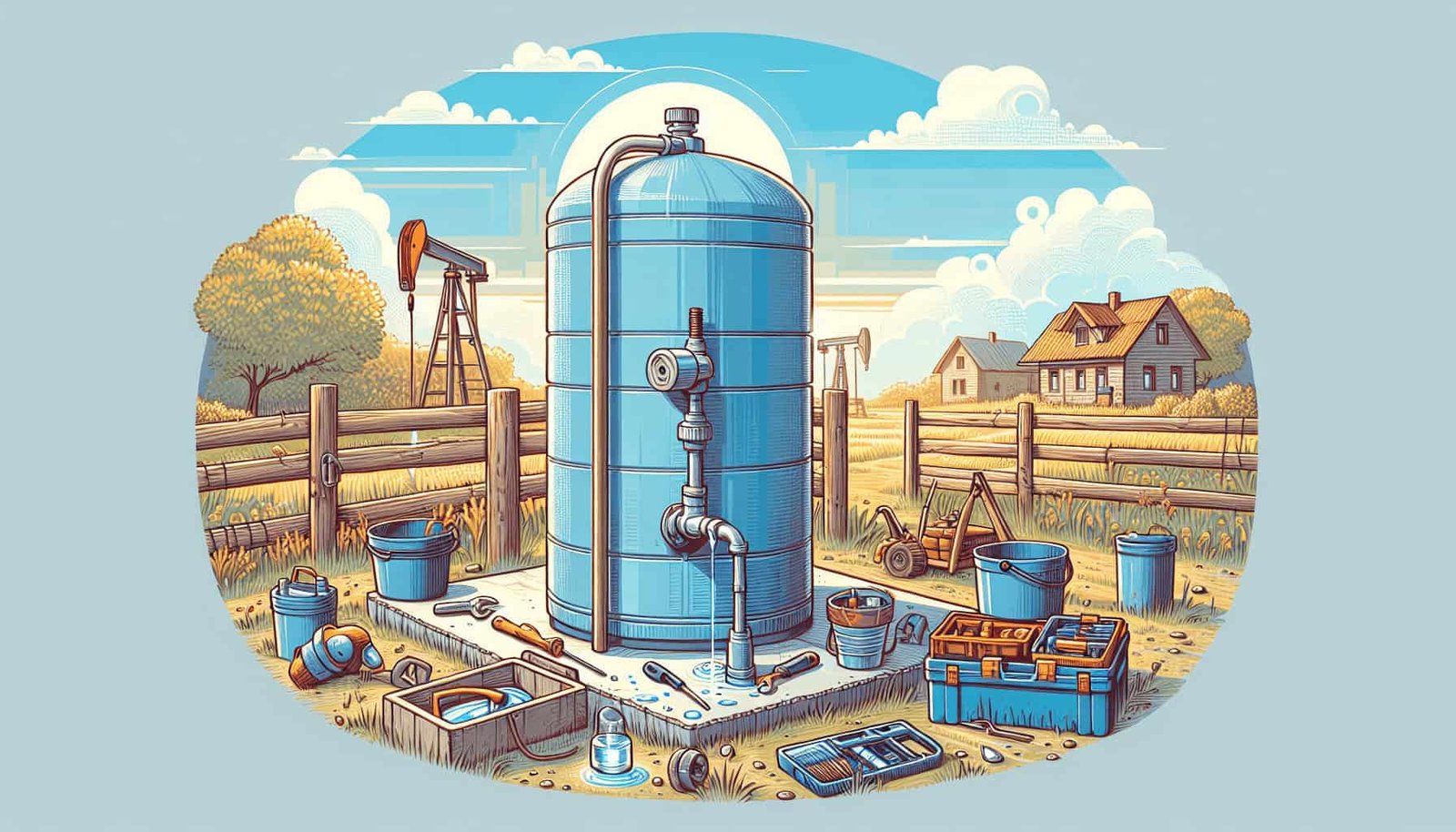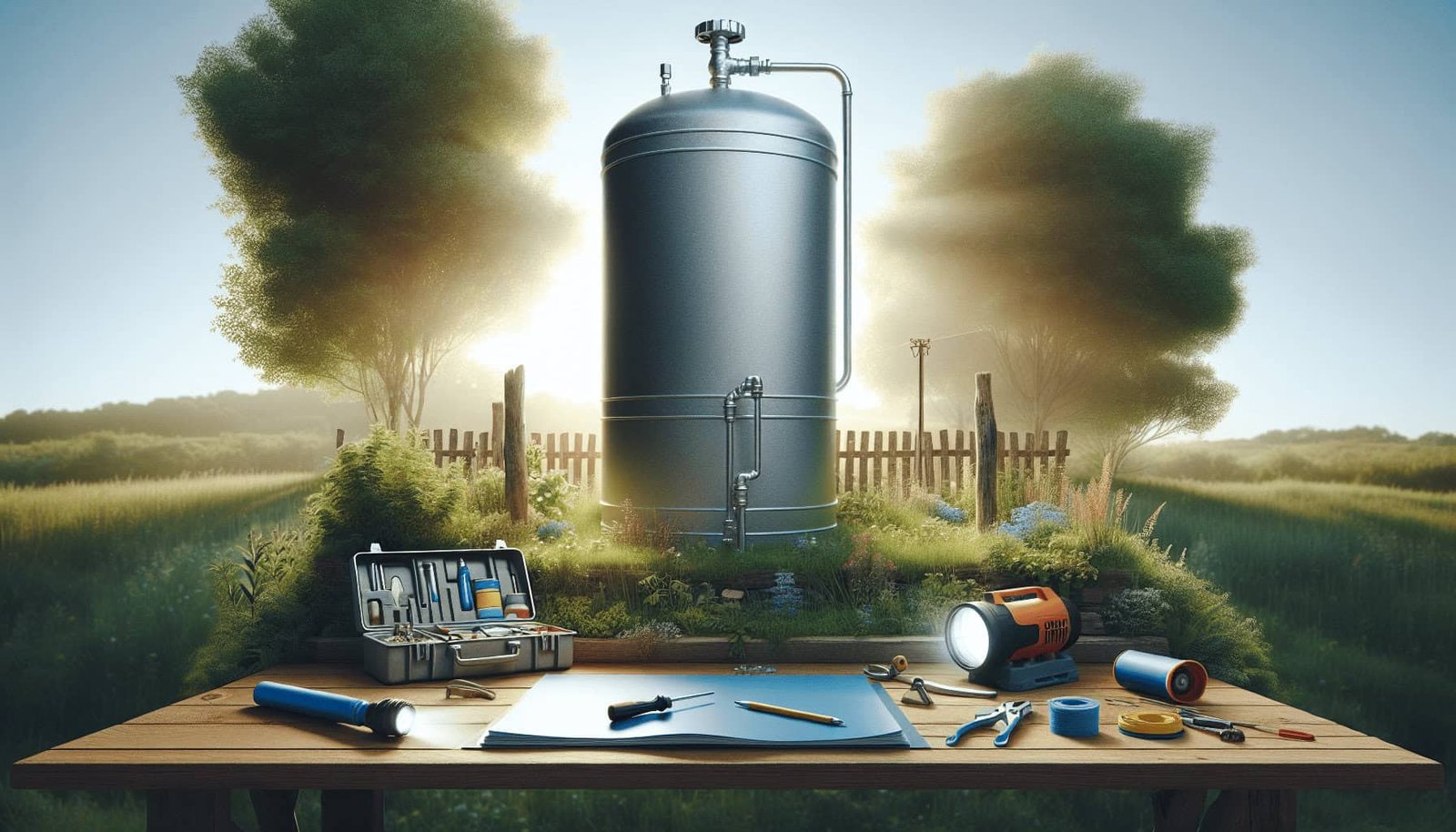Have you ever wondered how to ensure the safety of your well when it comes to maintaining the water pressure tank? In this article, we will explore different ways to protect your well from any safety issues that may arise during maintenance initiatives. From understanding the importance of regular inspections to implementing safety measures, we will provide you with the necessary knowledge and tips to keep your well in optimal condition. So, let’s dive right in and discover how you can safeguard your well and maintain its functionality while keeping safety at the forefront.

Importance of Well Water Pressure Tank Maintenance
Maintenance of your well water pressure tank is crucial in ensuring the safety and efficiency of your well system. Understanding the role of the pressure tank and the potential risks that may arise from neglecting maintenance is essential for every well owner. By identifying common safety issues, regularly inspecting and monitoring the pressure tank, implementing proper cleaning and sanitization practices, preventing water contamination, maintaining optimal water pressure, ensuring proper drainage, choosing professional assistance when needed, educating yourself on well maintenance, and establishing emergency preparedness, you can protect your well from safety issues associated with well water pressure tank maintenance initiatives.
Understanding the Role of the Well Water Pressure Tank
The well water pressure tank plays a vital role in your well system. Its main function is to store pressurized water, which allows for consistent water flow in your home. When the well pump fills the tank, it compresses air inside that helps maintain a steady pressure throughout the system. This enables you to have access to water whenever you need it, without experiencing pressure fluctuations or interruption in supply.
Why Maintenance is Crucial for Well Water Pressure Tanks
Regular maintenance of your well water pressure tank is essential to ensure its proper functioning and longevity. Neglecting maintenance can lead to various safety issues and potential damage to your well system. By keeping the pressure tank in good condition, you can prevent costly repairs, save water, and maintain a reliable water supply for your household.
Risk of Safety Issues if Maintenance is Neglected
Neglecting maintenance for your well water pressure tank can pose significant safety risks. Some of the common safety issues associated with neglected maintenance include pressure fluctuations, leaks and potential water damage, corrosion and its effects on tank longevity, and contaminant buildup with potential health concerns. By addressing these issues through regular maintenance, you can mitigate these risks and ensure the safety of your well system.

Identifying Common Safety Issues
Understanding the common safety issues that can arise from neglecting well water pressure tank maintenance is key to preventing larger problems. Here are some of the issues to look out for:
Pressure Fluctuations and Their Impact
Neglecting maintenance of the pressure tank can result in pressure fluctuations in your water supply. These fluctuations can cause discomfort, reduced water flow, and potential damage to appliances and plumbing fixtures. Monitoring pressure levels and addressing any irregularities promptly is essential to maintaining consistent and appropriate water pressure.
Leaks and Potential Water Damage
Leaks in the well water pressure tank can lead to water damage in your home. Not only can leaks waste water, but they can also cause structural issues and promote the growth of mold and mildew. Regular inspections and checking for signs of leaks are crucial preventive measures to avoid water damage.
Corrosion and Its Effects on Tank Longevity
Corrosion is a common problem in well water pressure tanks, especially those made of metal. Over time, corrosion can weaken the tank structure, leading to leaks and eventual failure. Regular visual inspections, as well as monitoring for signs of corrosion, can help identify and address this issue before it becomes a safety concern.
Contaminant Buildup and Health Concerns
Neglected well water pressure tanks can become a breeding ground for contaminants. Bacteria, sediment, and other particles can accumulate and contaminate your water supply, potentially causing health issues. Regular cleaning and sanitization of the tank are necessary to prevent the buildup of contaminants and ensure the safety of your well water.
Regular Inspection and Monitoring
To maintain the optimal performance and safety of your well water pressure tank, regular inspection and monitoring are crucial. Here are some important aspects of inspection and monitoring:
Establishing a Maintenance Schedule
Create a maintenance schedule to ensure regular and systematic inspections and monitoring of your pressure tank. This will help you stay on top of any potential issues and identify them before they worsen. Consider scheduling inspections at least once a year, or more frequently if recommended by a professional.
Importance of Visual Inspections
Visual inspections allow you to identify any visible signs of damage, leaks, or corrosion in your pressure tank. Look for signs of rust, discoloration, or bulging in the tank’s exterior. Additionally, inspect the connections, valves, and fittings for any loose or damaged components.
Monitoring Pressure Readings and Patterns
Regularly monitor the pressure readings of your well water pressure tank. By tracking the pressure patterns, you can identify any abnormalities or fluctuations that may indicate underlying issues. An abnormal pressure pattern may suggest a malfunctioning pump or a problem with the pressure tank.
Checking for Leaks and Signs of Corrosion
During inspections, check for any leaks or signs of corrosion in and around the pressure tank. Look for water puddles, dampness, or water stains near the tank. Inspect the tank for any signs of rust, discoloration, or weakened areas. Addressing leaks and addressing signs of corrosion promptly can prevent further damage and potential safety hazards.

Proper Cleaning and Sanitization
Cleaning and sanitizing your well water pressure tank on a regular basis is essential for maintaining its efficiency and preventing water contamination. Here are some steps to follow for proper cleaning and sanitization:
Understanding the Cleaning Process
Before cleaning the pressure tank, ensure you understand the cleaning process specific to your tank model. Refer to the manufacturer’s instructions or consult a professional if you are unsure. Familiarize yourself with the tank components and the steps required for disassembly and reassembly.
Steps for Sanitizing the Pressure Tank
Start the sanitization process by turning off the power supply to the well pump. This ensures a safe working environment. Drain the tank completely to remove any water or sediment. Prepare a sanitizing solution recommended for well water systems and follow the manufacturer’s instructions on the proper dosage and application method. Allow the solution to circulate within the tank for the specified duration. Finally, flush the tank thoroughly with clean water to remove any residual sanitizing solution.
Using Appropriate Cleaning Agents
When cleaning the pressure tank, it is important to use appropriate cleaning agents that are safe for well systems. Avoid using harsh chemicals or cleaners that may leave residue or damage the tank components. Opt for cleaners specifically designed for well water systems or consult a professional for guidance.
Frequency of Cleaning and Sanitization
The frequency of cleaning and sanitization depends on various factors including water quality, usage, and the type of pressure tank. As a general guideline, consider cleaning and sanitizing the pressure tank at least once every two to three years. However, if you notice any signs of contamination, foul odors, or changes in water quality, it is recommended to clean and sanitize the tank more frequently.
Preventing Water Contamination
Protecting your well water from external contaminants is essential for maintaining the safety and quality of your water supply. Here are some preventive measures to consider:
Protecting Well Water from External Contaminants
Ensure that your wellhead is properly sealed and protected to prevent the entry of surface water, debris, or contaminants. Regularly inspect the well cap and casing to ensure they are intact and properly sealed. Consider installing a well cap with a sanitary seal to provide an extra layer of protection against contamination.
Importance of Backflow Prevention Devices
Install backflow prevention devices in your well system to prevent the backflow of contaminated water into your water supply. Backflow can occur due to pressure changes, such as when using a garden hose connected to a chemical container. Backflow prevention devices act as a barrier, ensuring that water only flows in one direction, preventing contamination from reaching your well water.
Testing Water Quality Regularly
Regularly test the quality of your well water to identify any potential contaminants or issues. Testing should be conducted by a certified laboratory and include analysis for bacteria, nitrates, pesticides, and other contaminants specific to your area. Follow the recommended testing frequency and address any water quality concerns promptly.
Addressing Contamination Issues Promptly
If you suspect or confirm water contamination in your well system, take immediate action to address the issue. Contact a professional well contractor who can help identify the source of contamination and recommend appropriate treatment measures. Prompt action is crucial to prevent further contamination and ensure the safety of your water supply.

Maintaining Optimal Water Pressure
Maintaining the optimal water pressure in your well system is vital for the efficient operation and longevity of your pressure tank. Here are some important considerations:
Understanding the Ideal Pressure Range
The ideal pressure range for a well water pressure tank typically falls between 40 to 60 pounds per square inch (psi). This range provides sufficient pressure for household activities while reducing the strain on the tank and well pump. Understanding this ideal range is important for monitoring and adjusting your pressure settings.
Monitoring Pressure Levels and Adjusting as Needed
Regularly monitor the pressure levels in your well water pressure tank using a pressure gauge. If you notice pressure levels consistently below or above the ideal range, adjustments may be necessary. Consult a professional well contractor to guide you in adjusting the pressure settings for optimal performance.
Addressing Pressure Fluctuation Issues
Pressure fluctuations can disrupt the functionality of your well water pressure tank and cause inconvenience in your daily water usage. If you experience frequent pressure fluctuations, consult a professional well contractor to identify the underlying cause and implement necessary solutions. Addressing pressure fluctuation issues promptly can prevent further damage to your well system.
Maintaining Proper Air Pressure in the Tank
The air pressure in the pressure tank plays a crucial role in maintaining consistent water pressure. Ensure that the air pressure matches the manufacturer’s recommendations for your specific tank model. Periodically check and adjust the air pressure if needed, using a tire pressure gauge or an air compressor with an appropriate attachment. Maintaining proper air pressure helps the tank perform efficiently and extends its lifespan.
Ensuring Proper Drainage
A functional drainage system is essential for proper functioning and safety of your well water pressure tank. Here’s why drainage should be a priority:
Importance of a Functional Drainage System
A well-functioning drainage system allows for effective removal of excess water from your well water pressure tank. It prevents water accumulation, which can lead to pressure issues, damage to the tank structure, and potential safety hazards. A functional drainage system ensures that the tank operates optimally and prolongs its lifespan.
Checking and Maintaining Drain Valves
Regularly inspect the drain valves in your pressure tank to ensure they are in good working condition. Check for any signs of leaks, corrosion, or blockages in the valves. If you detect any issues, address them promptly by repairing or replacing the valves as necessary. Proper maintenance of the drain valves ensures effective drainage and prevents complications.
Preventing Water Accumulation and Stagnation
Water accumulation and stagnation in the pressure tank can lead to bacterial growth, foul odors, and degraded water quality. Ensure that your drainage system is functioning properly to allow for the removal of accumulated water and prevent stagnation. Regularly check for any signs of water accumulation and take appropriate measures to address the issue promptly.
Addressing Drainage Issues Promptly
If you encounter any drainage issues, such as slow or incomplete drainage, it is important to address them promptly. Consult a professional well contractor to diagnose the problem and provide suitable solutions. Delaying the resolution of drainage issues can lead to further complications and potential damage to your well system.

Choosing Professional Assistance
While regular maintenance can be carried out by well owners, there are instances where professional assistance is necessary. Here’s why choosing a qualified well contractor is beneficial:
Benefits of Hiring a Qualified Well Contractor
A qualified well contractor possesses the expertise, knowledge, and experience in dealing with well water pressure tanks. They have a deep understanding of well systems and can accurately diagnose and address safety issues. Hiring a professional ensures that your well water pressure tank is properly installed and maintained according to industry standards.
Ensuring Proper Installation and Maintenance
Professional well contractors have the necessary skills to install and maintain your well water pressure tank properly. They can ensure that the tank is correctly connected to your well system, preventing potential safety hazards. Additionally, they can provide guidance on maintenance practices specific to your pressure tank model.
Expertise in Identifying and Addressing Safety Issues
Well contractors have the expertise to identify and address safety issues associated with well water pressure tank maintenance. They know the common warning signs to look out for and can recommend appropriate solutions. By hiring a professional, you can have peace of mind knowing that safety issues are being effectively addressed.
Access to Specialized Equipment and Tools
Well contractors have access to specialized equipment and tools necessary for maintenance and repairs. They are equipped to carry out inspections, diagnose problems, and complete maintenance tasks efficiently. Utilizing their expertise and specialized equipment can ensure that your well water pressure tank is properly maintained and functioning optimally.
Educating Yourself on Well Maintenance
As a responsible well owner, educating yourself on well maintenance is essential for the long-term performance and safety of your well water pressure tank. Here are some ways to enhance your knowledge:
Understanding the Basics of Well Systems
Begin by familiarizing yourself with the basic components and operation of a well system. Learn about the roles of the well pump, pressure tank, and other essential elements. Understanding the functioning of your well system will help you better identify and address maintenance needs.
Researching Well Water Pressure Tank Maintenance
Engage in research specifically related to well water pressure tank maintenance. Explore reliable sources such as reputable websites, publications, and industry-specific materials. By staying informed about best practices and recommended maintenance procedures, you can effectively care for your well water pressure tank.
Attending Educational Workshops or Seminars
Consider attending educational workshops or seminars related to well maintenance. These events often provide valuable insights, expert advice, and hands-on demonstrations. Engaging in such learning opportunities can enhance your skills and knowledge, enabling you to better maintain your well water pressure tank.
Utilizing Online Resources for Well Maintenance Information
Take advantage of online resources that offer comprehensive information on well maintenance. Reputable websites, forums, and discussion boards are often excellent sources of tips, insights, and troubleshooting guidance. Participate in relevant online communities to share experiences and learn from others.
Importance of Emergency Preparedness
Being prepared for emergencies is vital for ensuring the safety and well-being of you and your household. Here’s why emergency preparedness is crucial:
Developing a Contingency Plan for Power Outages
Power outages can disrupt the functioning of your well water pressure tank, affecting your access to water. Develop a contingency plan for such circumstances, including backup power sources like generators or alternative water storage options. Having a plan in place ensures that you still have access to clean water during power outages.
Ensuring Access to Clean Water During Emergencies
In case of emergencies such as natural disasters or contamination incidents, access to clean water becomes essential. Store an emergency water supply that is properly treated, sealed, and regularly rotated to maintain its quality. This ensures that you and your household have access to safe drinking water during unexpected situations.
Having Contact Information of Well Maintenance Professionals
Keep a list of contact information for professional well contractors who can assist you during emergencies or urgent maintenance needs. In times of crisis, having access to reliable professionals who can promptly address safety issues can make a significant difference in protecting your well system.
Being Aware of Potential Safety Issues and How to Respond
Educate yourself about potential safety issues associated with your well water pressure tank and understand how to respond to them. Knowing the warning signs of a malfunctioning tank, contamination risks, or drainage issues enables you to take immediate action and prevent further damage. Stay informed and regularly review your maintenance practices to ensure the ongoing safety of your well system.
By understanding the importance of well water pressure tank maintenance, identifying common safety issues, regularly inspecting and monitoring, carrying out proper cleaning and sanitization, preventing water contamination, maintaining optimal water pressure, ensuring proper drainage, choosing professional assistance when needed, educating yourself on well maintenance, and prioritizing emergency preparedness, you can protect your well from safety issues associated with well water pressure tank maintenance initiatives. Regular maintenance and proactive measures are key to enjoying a safe, efficient, and reliable water supply from your well system.
